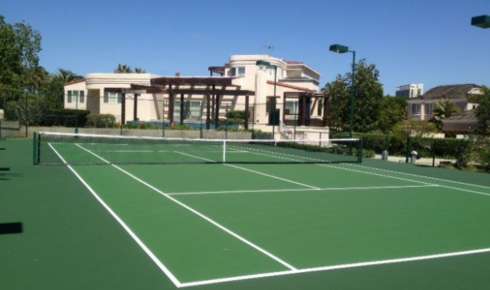Best Flooring Options for Outdoor Tennis Courts in India
Choosing the ideal surface for a tennis court is a key decision that influences play quality, durability, and safety. With tennis gaining popularity across schools, clubs, and private institutions, the demand for high-performance outdoor tennis court flooring in India has grown significantly. Whether you’re developing a residential court or a sports academy facility, selecting the right material ensures long-term usability and player satisfaction.
Why Tennis Court Surface Matters
The surface of a tennis court affects every aspect of the game—from ball bounce and movement speed to player comfort and injury risk. For outdoor environments in India, which face intense sun, heavy rain, and dust, flooring must offer UV resistance, non-slip properties, and efficient drainage. A good surface also supports regular use with minimal maintenance, making it essential to choose carefully from the available tennis court surface materials in India.
Synthetic Acrylic Flooring: The Most Preferred Choice
Among all types of tennis court flooring, synthetic acrylic is the most popular for Indian outdoor courts. This system involves multiple layers of acrylic coatings applied over a concrete or asphalt base. It provides a smooth, seamless surface that is both slip-resistant and weatherproof.
One of its strongest advantages is customizability. Acrylic systems allow for cushioned layers to be added for better shock absorption, making it suitable for all levels—from children to professional players. Additionally, these surfaces come with ITF approved tennis court surface classifications, ensuring consistent play speed and bounce.
Synthetic acrylic is also known for its aesthetic flexibility. Court owners can choose from a wide range of colors and textures while ensuring the surface meets international play standards.
Clay Courts: Traditional but Maintenance-Heavy
Clay courts, though classic in design, are rare in India due to their high maintenance needs. Made from crushed brick or shale, these surfaces offer a slower game and softer impact on joints. However, their daily upkeep, sensitivity to weather, and water dependency make them impractical for most Indian facilities.
While they are appreciated by advanced players for enhancing endurance and tactical play, they are not ideal for regions with heavy rainfall or frequent use.
Artificial Grass: Aesthetic but Less Practical
Another option among tennis court surface materials India sees is artificial turf. These synthetic grass courts are visually appealing and soft underfoot. However, their performance often falls short when it comes to bounce consistency and durability under frequent play. The turf fibers tend to flatten or wear out unevenly, affecting the court’s usability over time.
Though suitable for residential or low-traffic areas, artificial grass surfaces require periodic grooming and are not recommended for competitive training environments.
Plain Concrete Courts: Strong But Incomplete
Concrete courts are commonly used as a base for other flooring systems. On their own, they offer excellent structural durability but are not ideal for direct play. They lack cushioning and can be harsh on joints, making them unsuitable without additional surface treatment.
Typically, these courts are upgraded with synthetic acrylic coatings to create a proper non-slip tennis court flooring experience. This combination offers both durability and playability, which is essential for outdoor use.
Performance Benefits of Synthetic Tennis Court Flooring
Synthetic acrylic surfaces are designed to handle India’s diverse climate—be it extreme heat or heavy rains. These courts dry quickly, resist UV degradation, and remain playable throughout the year. They also require less effort to maintain, with occasional washing and repainting sufficing for years.
Their non-slip tennis court flooring characteristic ensures safer gameplay, even in humid or damp conditions. In busy sports academies or coaching centers, these features reduce downtime and improve efficiency.
Moreover, being ITF approved tennis court surface options, these synthetic systems enable certified coaching and competitive matches, adding significant value to the facility.
Cost and Maintenance Considerations
Budget plays a major role when selecting outdoor tennis court flooring in India. While synthetic acrylic surfaces might involve a higher initial investment compared to plain concrete or turf, their long-term value is much greater. Their low maintenance, long lifespan, and resistance to wear reduce overall costs over time.
Since resurfacing is only needed every 5 to 8 years, they prove economical for institutions and clubs with high daily usage. Additionally, their visual appeal and color retention boost the overall aesthetics of any facility.
Conclusion
India’s varied weather conditions demand a tennis surface that can perform reliably year-round. Among all types of tennis court flooring, synthetic acrylic offers the best combination of comfort, durability, and international play standards. Whether you’re building a court in a residential community, a school, or a professional academy, synthetic flooring stands out for its resilience, low maintenance, and player-friendly performance.
When selecting tennis court surface materials in India, it’s wise to prioritize long-term quality, safety, and certification. With features like UV resistance, slip protection, and customizable cushioning, synthetic tennis court flooring remains the top recommendation for any outdoor tennis court project.

